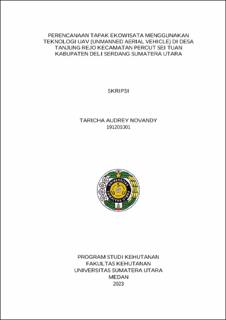| dc.description.abstract | UAV (Unmanned Aerial Vehicle) technology produces very high resolution images that make it possible to identify ecotourism potential so that development and site planning can be carried out in an area. One of the potential ecotourism areas to be developed is the mangrove forest in Tanjung Rejo Village, Percut Sei Tuan District, Deli Serdang Regency. This study aims to map land cover, identify potential and landscape constraints and conduct ecotourism zoning division using UAV (Unmanned Aerial Vehicle) Technology in Tanjung Rejo Village, Percut Sei Tuan District. Land cover classification is done by orthomosaic processing and classification using the OBIA (Object Based Image Analysis) method. Identification of potential and constraints is done with field observations, flora and fauna surveys, interviews and analysis of potential and constraints. The division of ecotourism zones is done through spatial analysis. Classification of aerial photographs resulted in 7 (seven) land cover classes. Land cover classes in the study area are water bodies, mangroves, palm oil, buildings, open land, ponds and roads. The highest land cover class in Tanjung Rejo mangrove is mangrove. The potential in the study site is the existence of a Forest Farmer Group (KTH) that already has an area utilization permit. At the study site there are 6 species of mangroves (Api - api black, Api - api white, Putut, Mata crocodile, Nipah, Bakau minyak) and 4 species of bird (pucung, sea grouse, white heron, little egret). Tanjung Rejo Village area is divided into 5 ecotourism zones. The ecotourism zone is divided into a reception zone of 0.95 ha, a service zone of 4.79 ha, a utilization zone which is divided into three with an area of 18.28 ha; 3.17 ha; and 1.17 ha respectively. Similarly, the core zone is divided into three with a total area of 25.55 ha and a buffer zone of 29.56 ha. The obstacles in the area are poor road access to the ecotourism site, the absence of mass transportation to the ecotourism site and the lack of synergy between the government and the community in managing ecotourism objects. | en_US |


